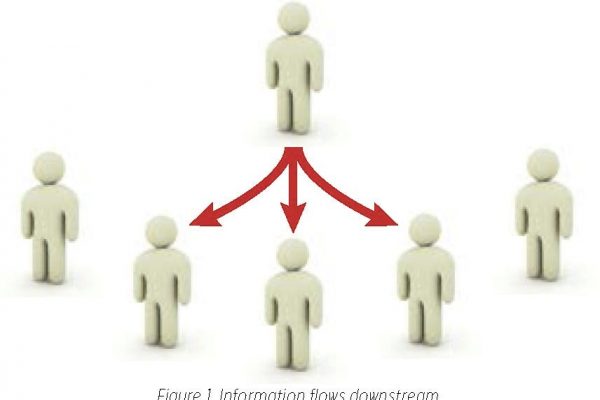A leadership reversal is needed
In our companies or communities, the revolution of the leadership is for now! This is the only way to meet the aspiration of involving stakeholders in decision-making process. This is the only way to take into account individual interests as collective interests. I use the term “revolution” deliberately and literally. It’s a real turnaround that our leaders, managers and executives must operate.
As evidence, let us look at some words from the vocabulary of today’s decision maker. First, he or she will talk about the need to “make people adhere”, whether it is to his or her team, company, or fellow citizens, to a common and shared vision. He or she will still speak of “give meaning” to the change he or she is about to manage. He will seek to “motivate” his or her troops. Finally, he will talk about “empowering” his or her managers, teammates and employees. And during all this, he or she will work hard to “manage stakeholders”.
Look at these sentences carefully because they are telling. The subject of each of these verbs is the leader himself. The original intention was to involve others, to make room for everyone, and to make sure everyone ends up finding his or her own way within the team initiative. But, in fact, it is merely a cover or a disguise. The means and the words chosen simply show that nothing has changed in the end: the information still flows downward and decisions are still made at the top and spread downstream.

The revolution to operate is to reverse these sentences. The goal is to make the subject of these sentences – the actor of these verbs – no longer the leader, but the team member him or herself, the employee of the company, the average citizen. The question is not to focus on the leader to “make people adhere”. The focus is that people decides to join” the initiative, “discover the meaning” of the project that is being proposed, “Get involved” in its realization, and “take responsibility” for its implementation. Regarding the stakeholders, the reversal is not to “manage then”, but for them to “agree” to the project and participate in discussions and decisions.
Sociocracy and dynamic gouvernance
In short, this change revives the word sociocracy invented in the 19th century by the French sociologist, Auguste Comte.
The autocrat has sole power. In a democracy it is the people who have the power. In sociocracy, governance is provided by the entire social body, that is to say, by the various related persons, and thus interdependent of each other. Americans, who do not like words that begin with “social”, describe this with the words “dynamic governance”.
It was not until the 1960s that sociocracy became operational, with the work of Gerard Endenburg. Endenburg is a Dutch engineer who inherited an electrical engineering business from his father. After a few years, marked by deep conflicts within the company, he decided to work to improve its organization.
He combined his work with Kees Boeke, an educator of whom he had been a student.
The objective was to implement socioc racy, this dynamic governance, with the central concept: no decision can be taken while argued objections remain. To achieve this, Endenburg develops four operational principles that are ex tremely simple:
-The circle: Within a sociocratic organization, each work unit belongs to a traditional hierarchical structure, but this work unit also consists in a “circle”. Operational issues remain treated by the traditional hierarchical structure; however, policy issues are dealt with within the circle. For example, one can imagine a project where all people responsible for deliverables are together in a circle. They decide on the strategic directions that should be taken. Once decisions are made, executions are carried out by the operational manager of the specific deliverable. In sociocracy, everyone belongs to at least one circle.
– The double link: Each circle is connected to the upper circle by two different people. The line manager on the one hand, and a representative delegated by the circle on the other hand. He or she can grant or withhold its consent on decisions taken at higher level. This double link provides two-way communication. With the double link, it is not possible to make a decision that condemns the rest of the organization or the project to failure.
-Consent: Decisions are made based on the consent of all. No decision can be taken while a participant makes a reasonable and argued objection; however, an objection commits its author to actively look for the solution, along with the entire circle. The goal is not to be all in agreement (and to achieve consensus), but that no one object (obtain consent).
-The election without a candidate: The skills and qualities needed to be a good candidate are different from those needed to be a good elected representative! And rare are those who have both! The last principle of Edenburg’s implementation of sociocracy addresses this dilemma. In sociocracy, elections do not require candidates. When specific responsibilities need to be assigned to someone, every member of the circle makes his or her suggestion and the person is chosen by consent from all members of the circle. To summarize sociocracy in one sentence : it is about learning to reconcile rather than choose, learning to switch from “or” which divides and separates to “and”, which brings together; and associate, to move away from the “yes but” toward the “yes and”.

Figment or reality?
Recently, someone told me: “sociocracy is a figment of the imagination!” He’s wrong. Sociocracy is a legal structure in The Netherlands. More and more organizations operate with systems of governance dynamics. Local authorities, such as Communities of Commons, have adopted such principles to strengthen democracy within their territory and involve citizens in the development of a development project. On the contrary – Not only it is not a figment of the imagination, but I believe, it is vital and necessary. Today’s leaders who will not evolve toward sociocracy will face resistance and strong opposition.



1 Comment
Noura · 29/05/2018 at 3:28 PM
As we are a government sector. We really need to make sociocracy and dynamic gouvernance in our future in order to be more transparent and more effective